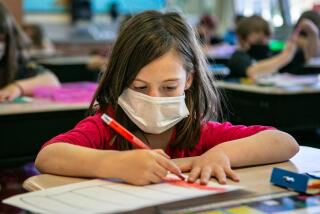Schools need reliable federal guidance on reopening. They still aren’t getting it
- Share via
One of the most frustrating aspects of the pandemic has been watching school districts try to navigate the complexities of remote learning with so little guidance from Washington. The silence is equally deafening when it comes to figuring out when and how districts should reopen their campuses.
Yes, the federal government provided much-needed funding, which helped buy computers and broadband access for students and cover other pandemic-related costs. Far more money is needed. But just as essential, if not more so, were information and directives about how to proceed in the current, unprecedented situation. And this is where the federal government has been sorely lacking.
School administrators aren’t epidemiologists; they don’t know when it’s safe to open schools and which measures to guard against the spread of the virus are most effective. And the Trump administration has, if anything, been counterproductive on this score.
President Trump’s main contribution was to tell districts, in effect: “Open all the school doors to full-time classroom learning, right now, or else!” It was an admonition designed more to restart the economy than educate students, and it was widely and rightly ignored.
Not surprisingly, Education Secretary Betsy DeVos’ main contributions were to suspend standardized testing last spring — if she hadn’t, no one would have tested anyway — and to echo the president’s words.
So it’s a relief to see President-elect Joe Biden’s incoming team making firmer plans. Like Trump, Biden’s advisors affirm the importance of getting students in school, but in their case they lay out the steps needed to get there — such as encouraging the closure of indoor dining at restaurants and other high-risk commercial activities before closing the schools that have reopened so far, and in order to open the ones that have remained closed. Those businesses would need bailouts to survive the pandemic, but the priority needs to be clear: This country and its students cannot afford a year without learning if we can help it. And Zoom meetings aren’t the answer.
Schools also need help understanding the parameters for safe reopening. We all do. When is it safe for students and teachers to be in the classroom? New York City, which already had reopened schools, now is closing them again after the rate of positive coronavirus tests more than doubled to 3%. But for New York state in general, a more generous figure of 5% is used. Other states and cities have their own rates.
Who’s right? None of these numbers are based on actual science showing that school attendance is safe at one level and unsafe at another. The people arguing for closure at one infection rate and reopening at another are no closer to the truth than Trump. People are basing their conclusions on one of two true statements: We don’t want to put teachers and communities at risk. It’s not healthy for kids to be learning remotely.
Of course, on the latter score Trump was mostly right. Students will learn best, and they and their families will be happier, when they can learn safely in regular classrooms. Those who need extra services will be fed. Their teachers and other educational professionals will be able to look for signs of depression or crisis in the family. They’ll be with friends.
What Trump left out, though, was the “safe” part of reopening.
We could be getting the answers we need. Schools opened in many corners of the nation, using different safety steps and in communities with different levels of infection. It’s a situation rich with data that has gone virtually ignored.
Anecdotal evidence seems to indicate that schools aren’t much of a COVID spreader. We haven’t seen big outbreaks connected to schools, in contrast with colleges. On the other hand, the number of infections at recently reopened schools in L.A. County jumped 63% in one week. Not all U.S. school districts are even reporting their infection data; they should be compelled to do so.
The nation doesn’t need to base these decisions on guesstimates and anecdotes. The federal government isn’t gathering or using the numbers that could be right in front of us to help inform decisions about opening schools. Before this school year is entirely lost, the Trump administration should start gathering and analyzing the data. That’s unlikely to happen, though, leaving the necessary work to the Biden administration.
More to Read
A cure for the common opinion
Get thought-provoking perspectives with our weekly newsletter.
You may occasionally receive promotional content from the Los Angeles Times.









